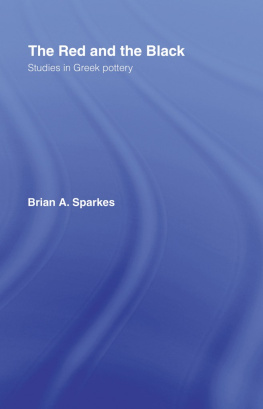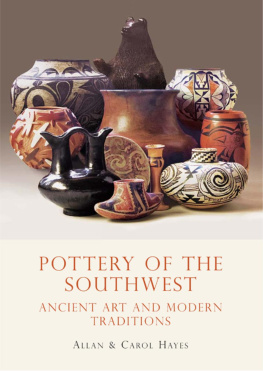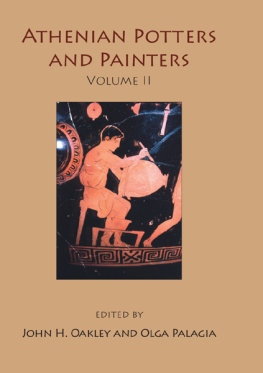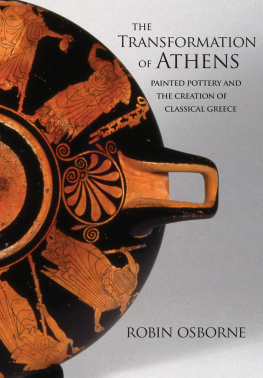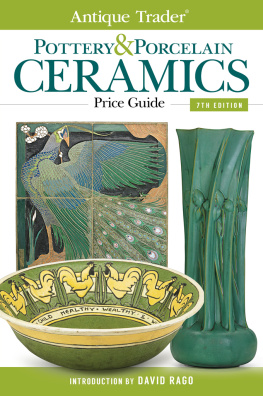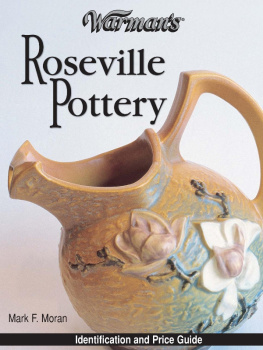THE RED AND THE BLACK

Greek painted pottery fetches high prices on the art market of today. The vases are very collectable, with their attractive shapes, decoration and figured scenes, with some carrying the signatures of individual craftsmen. The Red and the Black looks at the stages which have led to this enthusiastic urge to buy, and sets it against the history and significance of pottery production in ancient Greece.
In providing an accessible account of the production of pottery in ancient Greece, The Red and the Black explains how this pottery can be analysed with more emphasis on function than on aesthetics. From their form, the location when found, their decoration and their uses, much can be learnt about those who used these artefacts. This approach expands to cover the history of the study and collection of this pottery, from the Renaissance to the appeal which these objects exert on the markets today.
Brian Sparkess clear and entertaining explanations go beyond the bounds of traditional connoisseurship, taking a contemporary approach to the issues involved. In doing so, he has succeeded in producing a study which is of as much interest to the scholar, collector or general reader, as it is to the student who is entering the field of classical art and classical archaeology.
Brian A. Sparkes received his training in classics and archaeology at Kings College London and at the British School of Archaeology in Athens. He is currently Professor of Classical Archaeology at Southampton University. His most recent publications are Greek Art and Greek Pottery: An Introduction.

First published 1996
by Routledge
2 Park Square, Milton Park, Abingdon, Oxon, OX14 4RN
Simultaneously published in the USA and Canada
by Routledge
270 Madison Ave, New York NY 10016
Transferred to Digital Printing 2006
1996 Brian A. Sparkes
Typeset in Garamond by
Florencetype Ltd, Stoodleigh, Devon
All rights reserved. No part of this book may be reprinted or reproduced or utilized in any form or by any electronic, mechanical, or other means, now known or hereafter invented, including photocopying and recording, or in any information storage or retrieval system, without permission in writing from the publishers.
British Library Cataloguing in Publication Data
A catalogue record for this book is available from the British Library
Library of Congress Cataloguing in Publication Data
Sparkes, Brian A.
The red and the black: studies in Greek pottery/Brian A. Sparkes
p. cm.
ISBN 0415126606 (HB). ISBN 0415126614 (PB). ISBN 9781134525584 (EB)
1. Vases, Red-figured Greece. 2. Vases, Black-figured Greece.
3. Vases, Greek. I. Title.
NK4649.S68 1996
738.3820938dc20 9540622
CIP
ISBN 0415126606 (hbk)
ISBN 0415126614 (pbk)
eISBN 9780415126601
Publishers Note
The publisher has gone to great lengths to ensure the quality of this reprint but points out that some imperfections in the original may be apparent
Printed and bound by CPI Antony Rowe, Eastbourne
To the memory of
Lucy Talcott
(18991970)
and
Alison Frantz
(19031995)

The following list gives information, where possible, on the origin, shape, subject matter, date, findspot, size, and present location, together with a reference to a recent publication, either with a published photograph and discussion and/or a reference to further illustrations and discussion. The sources of the photographs are also listed. I am grateful to all museums and individuals who have supplied the material and granted permission for publication.

The chapters in this book are based on the lectures that I gave at the University of Aberdeen during the early months of 1992, when holding the Geddes-Harrower Chair of Classical Art and Archaeology. I am very grateful to the University for inviting me to speak there and for the hospitality extended to me when I was in residence. I am particularly grateful to Patrick Edwards, John Fraser and Liz Weir, of Kings College.
Some of the lectures have been delivered on other occasions, and I have benefited from comments and new information offered to me from time to time. I am also grateful for the critical remarks made by the two anonymous readers to whom the text of the lectures was sent by the publishers.
Transfer from the lecture format to the page is never easy, and there have naturally been changes: fewer illustrations, expansion of certain aspects for which there was no time in the lecture hours at my disposal, a rather less jaunty style. However, I hope I have retained some of the flavour of the occasions. The chapters have emerged with an art-historical bias, but that at least suits one aspect of the professorial title under which the lectures were delivered. For the emphasis on Athens there is no similar excuse. This is not a book for professional students of Greek pottery, but for those who are less acquainted with the subject, its pleasures and its personalities (ancient and modern).
The bibliography, now it is finished, looks more daunting than I had wanted it to be; it is intended to direct readers to more extended treatments of some of the themes. I have also listed an annotated selection of useful books and articles at the end of each chapter.
I have given a detailed list of illustrations on pp. viiixxi, and I am grateful to all the museum curators and private owners who have given me permission to publish the photographs. I hope that I have been punctilious in chasing up permissions; for those I have missed, my apologies. I am also grateful to the Carcanet Press for permission to quote from Robert Gravess poem Ogres and Pygmies.
I have received much help from Vicky Peters and Joanne Snooks of the Routledge staff and from Hannah Hyam whose copy-editing eye saved me from many sins of commission and omission.
I owe a deep debt of gratitude to the University of Southampton for a grant to cover the costs of the illustrations. The drawings and profiles were executed by Alan Burn and his team in the Cartographic Unit of the University; my thanks to them.
The dedication expresses my appreciation to two of the central figures in the American excavations of the Athenian Agora, Lucy Talcott and Alison Frantz: for many years they both helped to make young scholars, of whatever nationality, feel that they were an important part of the academic fellowship there. They are sadly missed.
BAS
June 1995

PUBLICATIONS
| AA | Archologischer Anzeiger |
| ABSA | Annual of the British School at Athens |
| AJA | American Journal of Archaeology |
| AK | Antike Kunst |
| AM | Athenische Mitteilungen |

